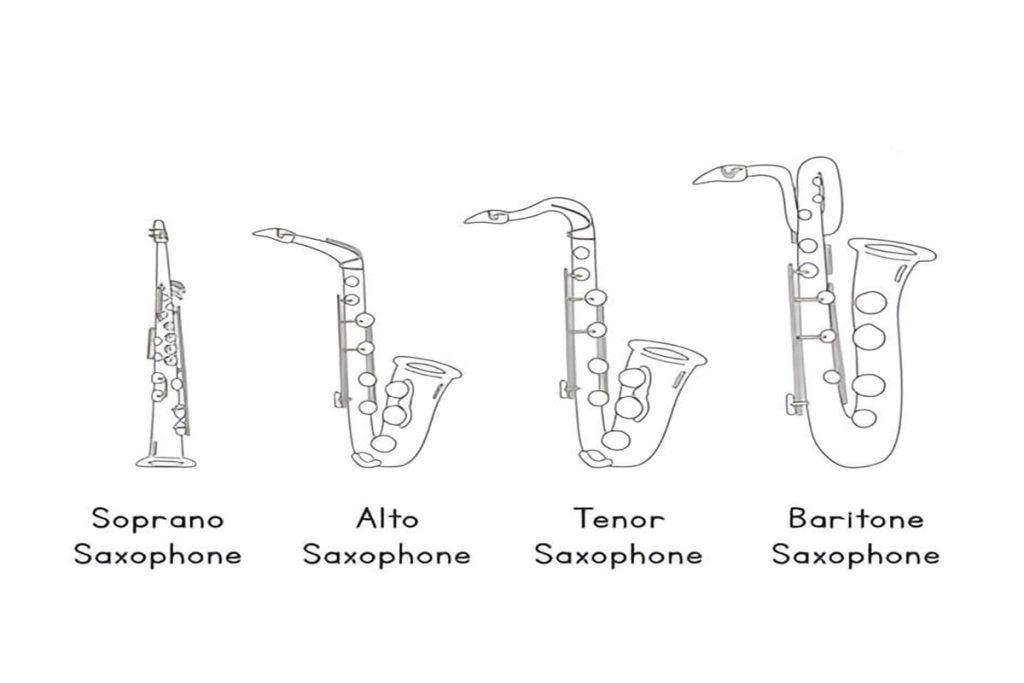
The saxophone family is a fascinating branch of woodwind instruments that has captivated musicians and audiences alike with its rich, expressive sound. Invented by Belgian instrument maker Adolphe Sax in the 1840s, the saxophone quickly gained popularity for its unique ability to blend the qualities of both brass and woodwind instruments. Understanding the diverse types within the saxophone family is essential for appreciating their role in various musical genres.
The saxophone family includes several different types, each varying in size and pitch range. The most commonly recognized members are the soprano, alto, tenor, and baritone saxophones. Each type offers distinct tonal characteristics: the soprano is known for its bright and piercing sound; the alto provides a balanced tone suitable for solos; the tenor delivers a warm, full-bodied resonance, while the baritone adds depth with its robust low register.
Historically, saxophones have played pivotal roles across numerous musical styles, from classical compositions to jazz ensembles and contemporary pop music. Their versatility allows them to adapt seamlessly into various settings, making them indispensable in both orchestras and small bands.
Understanding these different types not only enriches our appreciation of their individual contributions but also highlights how each member of this remarkable instrument family continues to shape music today. Whether you’re an aspiring musician or simply an enthusiast eager to learn more about woodwind instruments’ history, delving into the world of saxophones promises an exciting journey filled with discovery and inspiration.
The Most Common Types of Saxophones and Their Characteristics

The saxophone family is rich and diverse, offering a variety of instruments that cater to different musical styles and preferences. Among the most common types of saxophones are the soprano, alto, tenor, and baritone saxophones, each with its unique characteristics.
The soprano saxophon is the highest-pitched member of the saxophone family. Its straight design resembles that of a clarinet more than its curved counterparts. Known for its bright and penetrating sound, the soprano saxophone is often used in jazz and classical music settings to deliver clear melodic lines.
Next in line is the alto saxophone, which is perhaps one of the most popular choices for beginners due to its manageable size and versatile sound. The alto has a warm tone that balances between brightness and depth, making it suitable for various genres from jazz to classical ensembles.
The tenor saxophone offers a deeper pitch compared to the alto but retains a powerful presence in any musical arrangement. Its rich timbre makes it a staple in jazz bands, where it often takes on lead melodies or provides robust harmonic support.
Finally, there’s the baritone saxophone, which produces deep bass notes that anchor musical pieces with its resonant tones. Despite being larger and heavier than other common saxophones, it plays an essential role in both jazz bands and concert ensembles by providing depth to harmonies.
Understanding these common types of saxophones helps musicians choose an instrument that best fits their style while appreciating each one’s contribution to diverse musical landscapes.
Rare and Specialized Saxophones You Might Not Know About
When we think of saxophones, the alto, tenor, and soprano varieties often come to mind. However, there exists a fascinating world of rare and specialized saxophones that offer unique sounds and intriguing histories.
The bass saxophone is one such instrument that stands out with its deep, resonant tones. Larger than the more commonly seen baritone saxophone, the bass saxophone is a commanding presence in any ensemble. Its rich sound is perfect for adding depth to jazz bands or even classical compositions.
Even more formidable in size is the contrabass saxophone. This behemoth of an instrument can reach nearly two meters in height and produces some of the lowest notes possible on a wind instrument. Though not frequently seen due to its size and cost, it provides an unparalleled sonic experience when featured in performances.
On the opposite end of the spectrum lies the sopranino saxophone. Smaller than its soprano counterpart, this diminutive instrument delivers bright and piercing tones that can add a distinctive flair to any musical piece. Its high pitch makes it less common but highly valued among musicians seeking unique sound palettes.
Lastly, there’s the C melody saxophone, a relic from the early 20th century designed for home use as it plays in concert pitch (C). While it fell out of favor during the rise of jazz music due to its softer sound compared to B-flat or E-flat instruments, it’s experiencing a resurgence among collectors and musicians who appreciate its mellow timbre for certain genres.
Exploring these rare and specialized saxophones opens up new possibilities for both performers and listeners alike, expanding our understanding of what this versatile family of instruments can offer beyond traditional boundaries.
The Role of Each Type of Saxophone in Different Music Genres
Saxophones, with their rich and versatile sound, have found a place in various music genres, each type playing a unique role. In jazz music, saxophones are indispensable. The alto and tenor saxophones are particularly popular as jazz music instruments due to their expressive range and ability to convey emotion. These instruments are often featured in solos that highlight the improvisational nature of jazz.
In classical music, the soprano and baritone saxophones take center stage. Though not traditionally associated with this genre, they have carved out a niche as classical music instruments. Composers appreciate their ability to blend seamlessly with orchestras while adding a distinct timbre that enriches the overall sound palette.
Rock bands also incorporate saxophones into their lineups, with the tenor and baritone saxophones being favored choices. As rock band instruments, they contribute powerful riffs and energetic solos that enhance the dynamic atmosphere of live performances.
In big band setups, all types of saxophones come together to create a harmonious blend that is both robust and sophisticated. The alto saxophone often leads melodies while the tenor provides depth; meanwhile, the baritone anchors the harmony with its deeper tones. This combination is essential for achieving the full-bodied sound characteristic of big band ensembles.
Each type of saxophone brings its own flavor to these diverse musical landscapes, demonstrating its adaptability across genres while enriching them with its distinctive voice.
Choosing the Right Saxophone for Beginners vs Professionals
When it comes to selecting the right saxophone, the needs of beginners differ significantly from those of professional musicians. Understanding these differences is crucial in making an informed choice.
For beginners, a key consideration is finding an instrument that balances quality with affordability. A beginner’s guide to choosing a saxophone often emphasizes student models, which are designed to be more forgiving and easier to play. These models typically feature durable materials and straightforward mechanics, making them ideal for those just starting their musical journey. Brands like Yamaha and Jupiter offer reliable student models that provide a solid foundation without overwhelming new players with complexity.
On the other hand, professional musicians require instruments that can deliver superior sound quality and advanced features. Professional models are crafted with high-grade materials and precise engineering to produce rich tones and allow for greater expression in performance. These saxophones are often hand-finished and come with customizable options tailored to the musician’s specific preferences. Tips from seasoned professionals suggest considering brands like Selmer or Yanagisawa when seeking a saxophone that meets the demands of professional playing.
Whether you’re browsing as a novice or an experienced player, understanding your level of expertise and your musical goals will guide you in choosing between a student model vs. professional model saxophone. Investing time in research and perhaps consulting with music educators or fellow musicians can also provide valuable insights into making the best choice for your needs.
Maintenance Tips for Longevity and Sound Quality of Your Saxophone
Proper care and maintenance are crucial for preserving the longevity and sound quality of your saxophone. Regular upkeep not only ensures that your instrument performs at its best, but also helps prevent costly repairs down the line. Here are some essential sax maintenance tips to keep your woodwind in top condition.
First, cleaning your instrument after each use is vital. Moisture buildup can lead to corrosion and affect sound quality, so make it a habit to swab the inside of the saxophone with a clean, lint-free cloth after playing. Pay special attention to the neck and mouthpiece, as these areas accumulate most of the moisture.
Next, maintaining sound quality in woodwinds involves regular checks on pads and keys. Inspect pads for any signs of wear or damage; if they appear sticky or discolored, it might be time for a replacement. Also, ensure that keys move smoothly without any resistance or noise, applying a small amount of key oil can help maintain their fluidity.
Additionally, store your saxophone properly when not in use. A sturdy case protects it from dust and physical damage while ensuring consistent temperature conditions that prevent warping.
Explore the World of Saxophones and Enhance Your Musical Journey
As we reach the conclusion of our exploration into the world of saxophones, it’s clear that this versatile instrument offers a rich tapestry of musical possibilities. Whether you’re a seasoned musician or just beginning your journey, the saxophone can enhance your musical experience with its unique sound and expressive capabilities. From jazz to classical, rock to pop, the saxophone has made its mark across genres, proving its adaptability and appeal.
Delving into the history and evolution of this instrument reveals not only technological advancements but also cultural shifts that have influenced music worldwide. Understanding these aspects can deepen your appreciation and inspire new creative endeavors.
If you’re considering picking up the saxophone, remember that choosing the right type (whether it’s an alto, tenor, soprano, or baritone) can significantly impact your playing style and preferences. Each type brings its own character and challenges but ultimately contributes to a fulfilling musical journey.
Investing time in learning techniques specific to the saxophone will pay dividends in developing your skills. Embrace opportunities for practice and performance as each experience will refine your abilities further.
In summary, exploring the world of saxophones is more than just learning an instrument; it’s about embarking on a path filled with discovery and artistic growth. So grab your saxophone and let it be your guide in enhancing not only your musical journey but also enriching those who hear you play.
